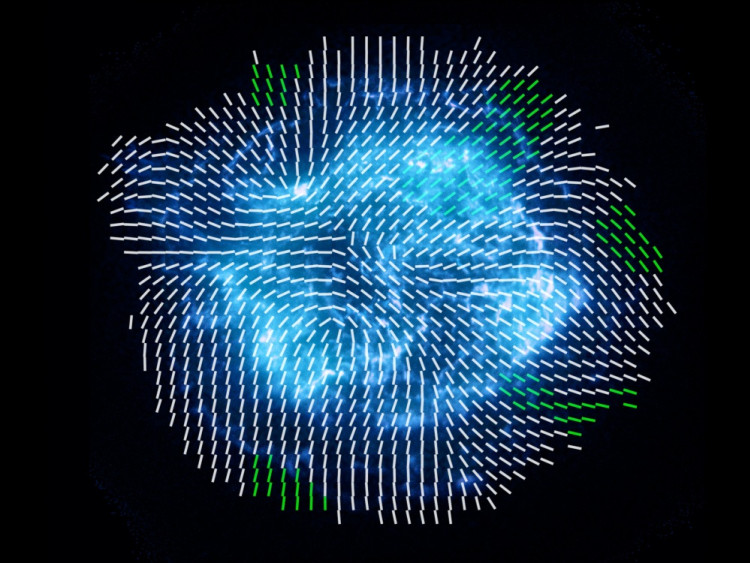Thanks to the new IXPE space telescope from NASA and Italy's ASI, astronomers were able to capture polarized X-ray light from stars and remnants of supernovas for the first time. Launched in late 2021, the X-ray telescope started its operations with observations from Cassiopeia A. That was lucky for Jacco Vink (University of Amsterdam). He has been researching 'Cas A' for years. Six months ago, for example, he discovered that the exploding nebula does not expand uniformly. Now the unexpected magnetic fields have been added.
Cassiopeia A is the remnant of an exploding star in the Cassiopeia constellation about 11,000 light years away. Around 1670, light from the explosion should have reached Earth for the first time. However, there was too much gas and dust around the star to see the explosion with the naked eye or with the then primitive telescopes.
![Ingekleurde afbeelding van Cassiopeia A gebaseerd op gegevens van de ruimtetelescopen Hubble, Spitzer en Chandra. (c) NASA/JPL-Caltech [via Wikimedia]](/upload/750x571/images/2022/10/Cassiopeia_A-credit-NASA-JPL-Caltech.jpg)
Colored image of Cassiopeia A based on data from the space telescopes Hubble, Spitzer and Chandra (c) NASA/JPL-Caltech [via Wikimedia].
Chaotic direction of the magnetic field
Astronomers can get a lot of information from the so-called polarization or vibration direction of light. Until now, there were no telescopes that could capture polarized X-ray light. The IXPE telescope can.
"We assumed that near the shock waves in Cas A one magnetic field direction would dominate, because the shock compresses the magnetic field in a direction along the shock," Jacco Vink explains. "Then you would expect 70% of the X-ray light to be polarized and parallel to the shocks. The new observations show that only 5% is polarized. So we conclude that behind the shock there are all kinds of processes that make the magnetic field directions chaotic again."
The theory of multiple magnetic fields, by the way, is not entirely unexpected. Previous measurements of radio radiation, not X-rays, also showed only 5% polarized light.
Thin wisps behind shock wave
"There is still a difference between radio and X-ray," adds co-researcher Dmitry Prokhorov (University of Amsterdam). "Radio comes from a larger area than X-ray. In radio, we saw that the magnetic fields from the shocks are directed outward, like the spokes of a wheel. In X-ray, we see magnetic field directions in thin strands just behind shocks. Apparently there are processes that rapidly scramble magnetic field directions behind the shock. But what those processes are, we don't know yet."
Meanwhile, the researchers are also measuring polarized X-ray light from other stars and supernova remnants with the IXPE telescope. They are also looking at Cas A together with the new James Webb Space Telescope, analyses of which are expected in the near future. Then it may become clearer what is happening at Cas A.
Polarization
Light is not only a beam that moves forward, but also a wave that goes up and down. This vibration is also called polarization. Normal sunlight vibrates in all directions. It is unpolarized. For example, when sunlight reflects off water, it becomes polarized and vibrates with a preferred direction.
Astronomers extract information from the polarization of light, among other things, about the directions of a magnetic field in tenuous gases in the universe. Until recently, only visible light and radio radiation could be used to determine the direction of polarization. But the IXPE space telescope can capture polarized X-rays.
Scientific article
X-ray polarization detection of Cassiopeia A with IXPE. By: Jacco Vink, et al. In: The Astrophysical Journal, Volume 938, Oct. 12, 2022. Original (open access) | Preprint

The magnetic fields of Cassiopeia A. The white and green dashes are magnetic fields measured with the IXPE telescope. The underlying blue image was made with the Chandra telescope. At the green dashes, the signal is the strongest, the most reliable. Much of the magnetic field in Cas A, contrary to expectations, does not have a strong preferred direction. The magnetic field is largely chaotic. (c) NASA/Vink et al. [large format].
